6.2.2 Case Study II - Groundwater Management in the Hessian Ried in Germany
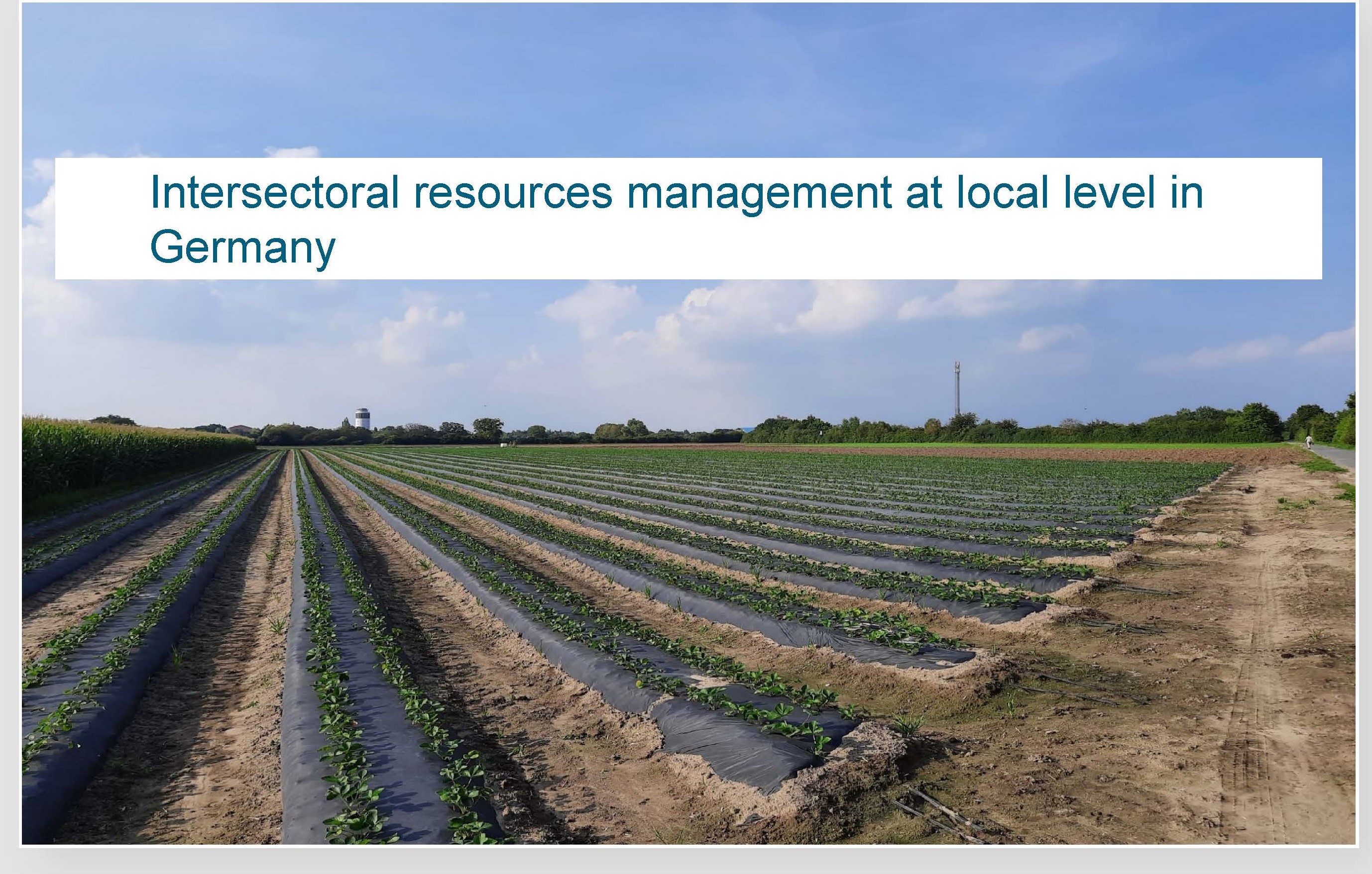
The case study is an example of the application of following WEF-Nexus coordination instruments:
- Communicative instrument: Ground Water Management Plan
- Legislative policy instrument: Targeted groundwater extraction values
- Organizational instrument: Round table discussions
The Hessian Ried
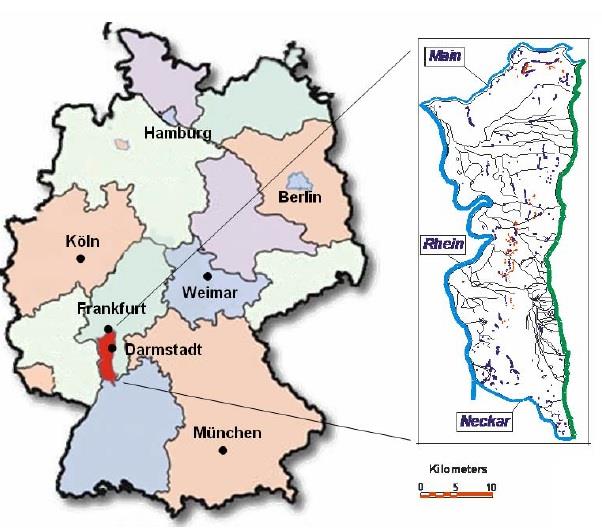
Rueppel & Gutzke, 2004
The Hessian Ried, located south of Frankfurt, extends over an area of approximately 1,250 km2. The landscape is a part of the Upper Rhine Plain, and prior to human intervention was a swamp area and part of the natural inundation zone of the Rhine River. Through widespread drainage and agricultural utilisation, the landscape was starkly changed.
The following user interests are dominant in the area:
- Agriculture
- Industry / infrastructure
- Drinking water use
- Nature conservation
User conflicts
arise from:
- Alteration of natural landscapes to cultivated landscapes;
- Pollution inputs from agriculture;
- Intensive exploitation of groundwater resources.
The intensive exploitation refers to the fact that due to the spatial locations of population centres and other geographically-centred points of extraction, the groundwater extraction rates do not match recharge rates over the spatial plain.
In dry years, considerable damages to infrastructure have been caused by low groundwater levels.
Dry years in the Hessian Ried
Extreme dry years in 1970s drastically increased the demand for water - especially for agricultural irrigation. The groundwater dropped to an extremely low level causing:
- forest dieback,
- road damages,
- failures in agricultural irrigation.
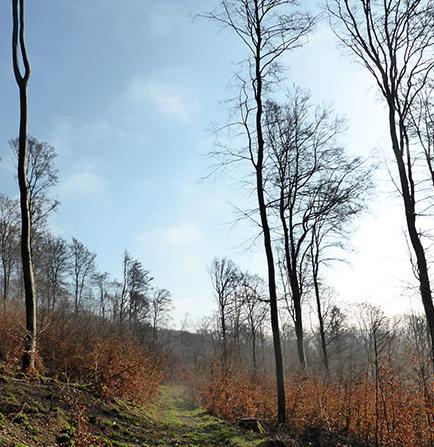
Rueppel & Gutzke, 2004
Wet years in the Hessian Ried
On the otherside, due to high precipitation in the 2001, in many places the highest groundwater levels in the last 40 years were reached causing waterlogging and flooding.
Solution:
The Hessian Ried Groundwater Management Plan – legally binding instrument
Two main instruments of Groundwater Management:
- Groundwater recharge to ensure water availability for irrigation and drinking water supply.
- Monitoring network with defined target values for groundwater levels.
Groundwater recharge
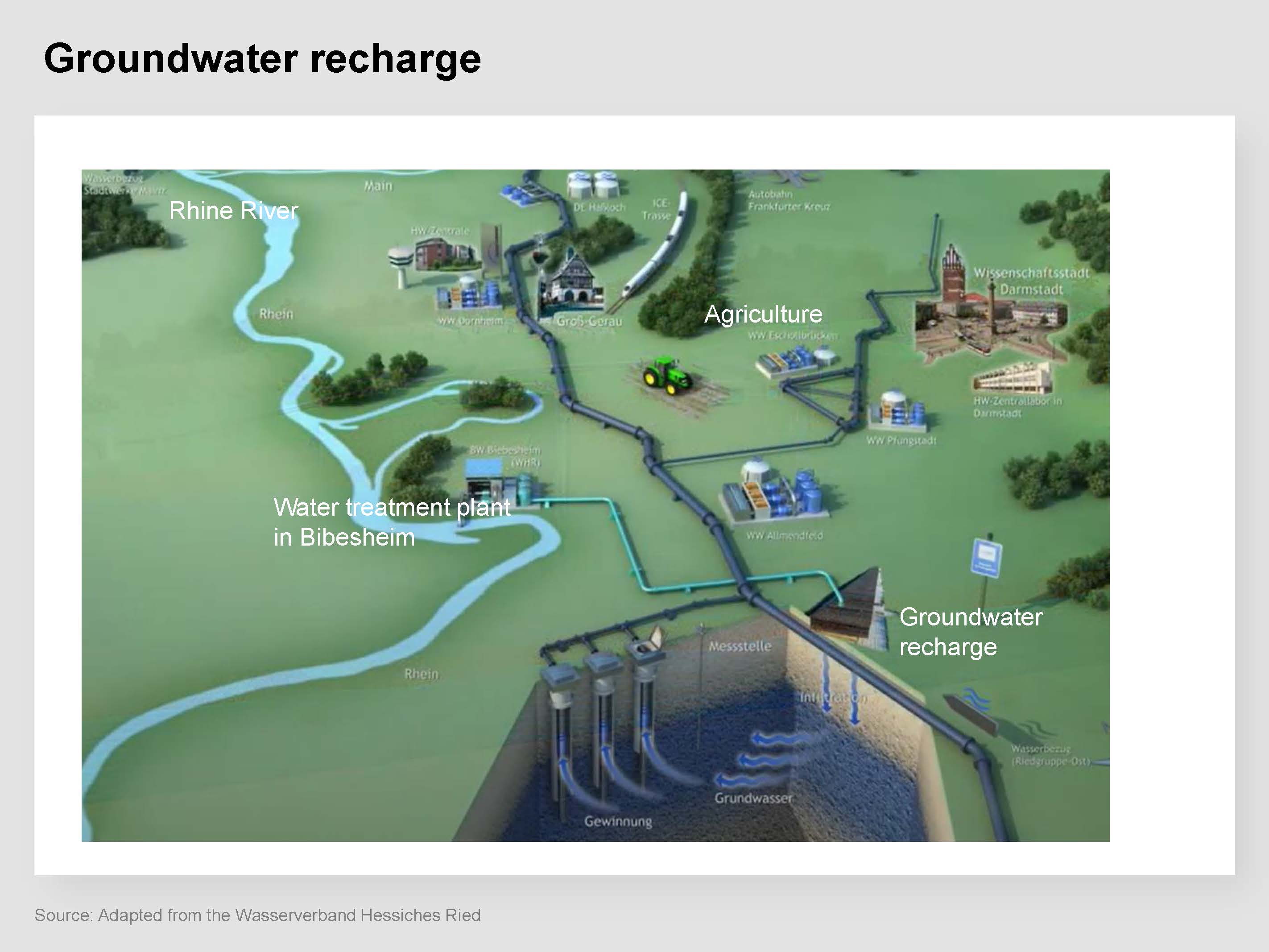 Source: Adapted from the Wasserverband Hessiches Ried
Source: Adapted from the Wasserverband Hessiches Ried
The diagram above summarizes the groundwater recharge: The water from the Rhine River is transported through a pipe system to the water treatment plant in Bibesheim. Though the treatment process in Bibesheim the water obtains drinking water quality. The drinking water quality is required to avoid groundwater pollution through the groundwater recharge process. After reaching the drinking water quality the water is distributed for the groundwater recharge and for agriculture.
Groundwater monitoring network in the Hessian Ried
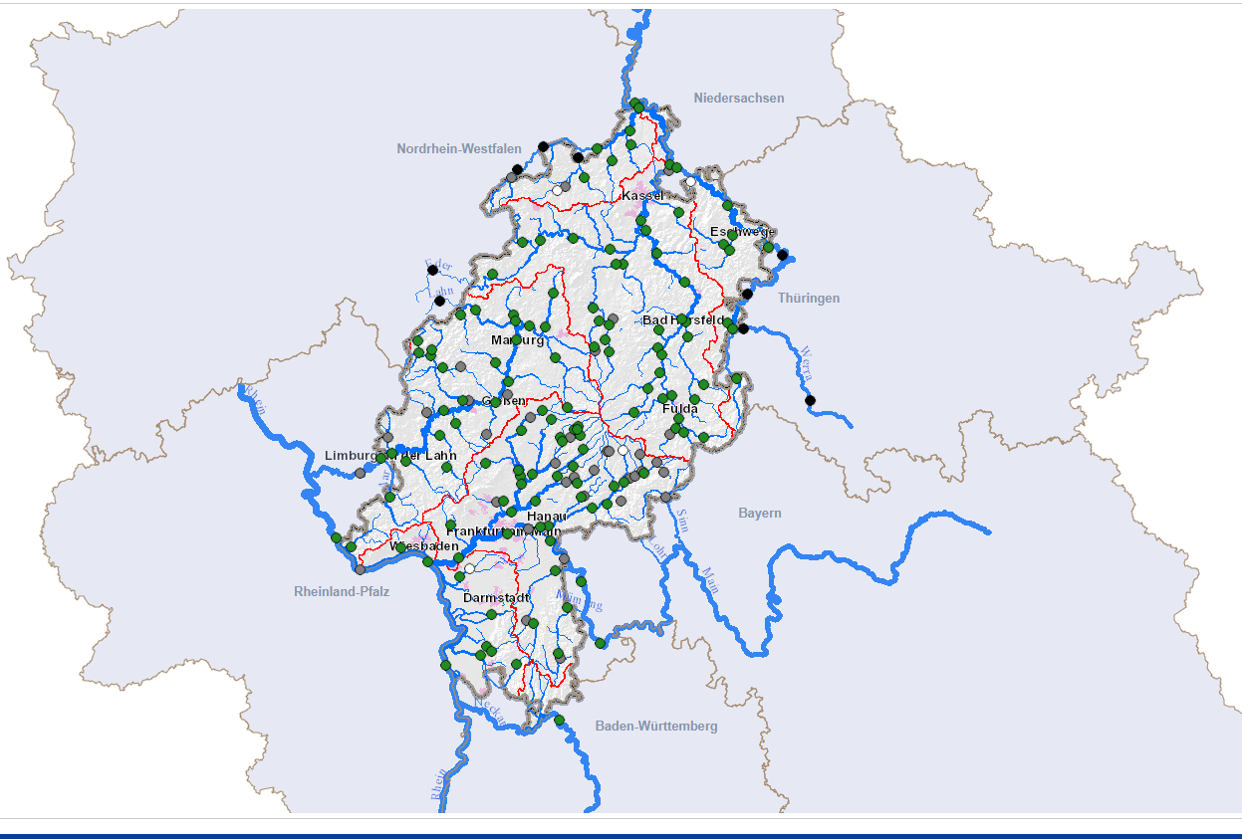 Source: Hessian Agency for Nature Conservation, Environment and Geology (HLNUG), available at: https://www.hlnug.de/static/pegel/wiskiweb2/index.html
Source: Hessian Agency for Nature Conservation, Environment and Geology (HLNUG), available at: https://www.hlnug.de/static/pegel/wiskiweb2/index.html
The groundwater level in the Hessian Ried is measured at about 850 monitoring stations.
Solution: Groundwater Management
Measured groundwater levels at a station in the Hessian Ried
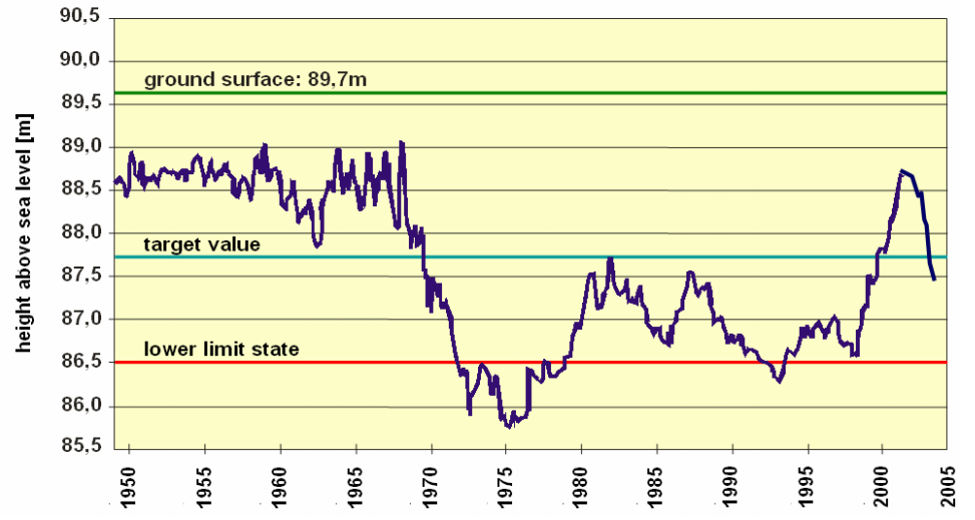 Rueppel & Gutzke, 2004
Rueppel & Gutzke, 2004
Based on sixty years of experience in monitoring groundwater levels in the Hessian Ried, the district government defined target values for the groundwater level which are adequate for the environment. The measured values in the monitoring stations and the expected water demand are used to control the groundwater recharge in accordance with the target value.
By water levels below the target value the infiltration takes place. By high levels it doesn´t.
Solution:
Round Table – Voluntary Cooperation
- The primary objective of the round table was to achieve a sustainable improvement of forest conditions in Hessian Ried.
- The round table operated under a neutral moderation process.
- A carefully arranged round table under neutral management created trust and enabled viable compromises.
However, for the forest the instruments implemented with the groundwater management plan were not sufficient.
The water level was too low for the forest and caused damages. This point was heavily disputed between the sectors forestry and water. To solve the conflict, 2012 the Hessian Ministry of the Environment, Climate Protection, Agriculture and Consumer Protection provided financial resources to establish a round table and look for solutions.
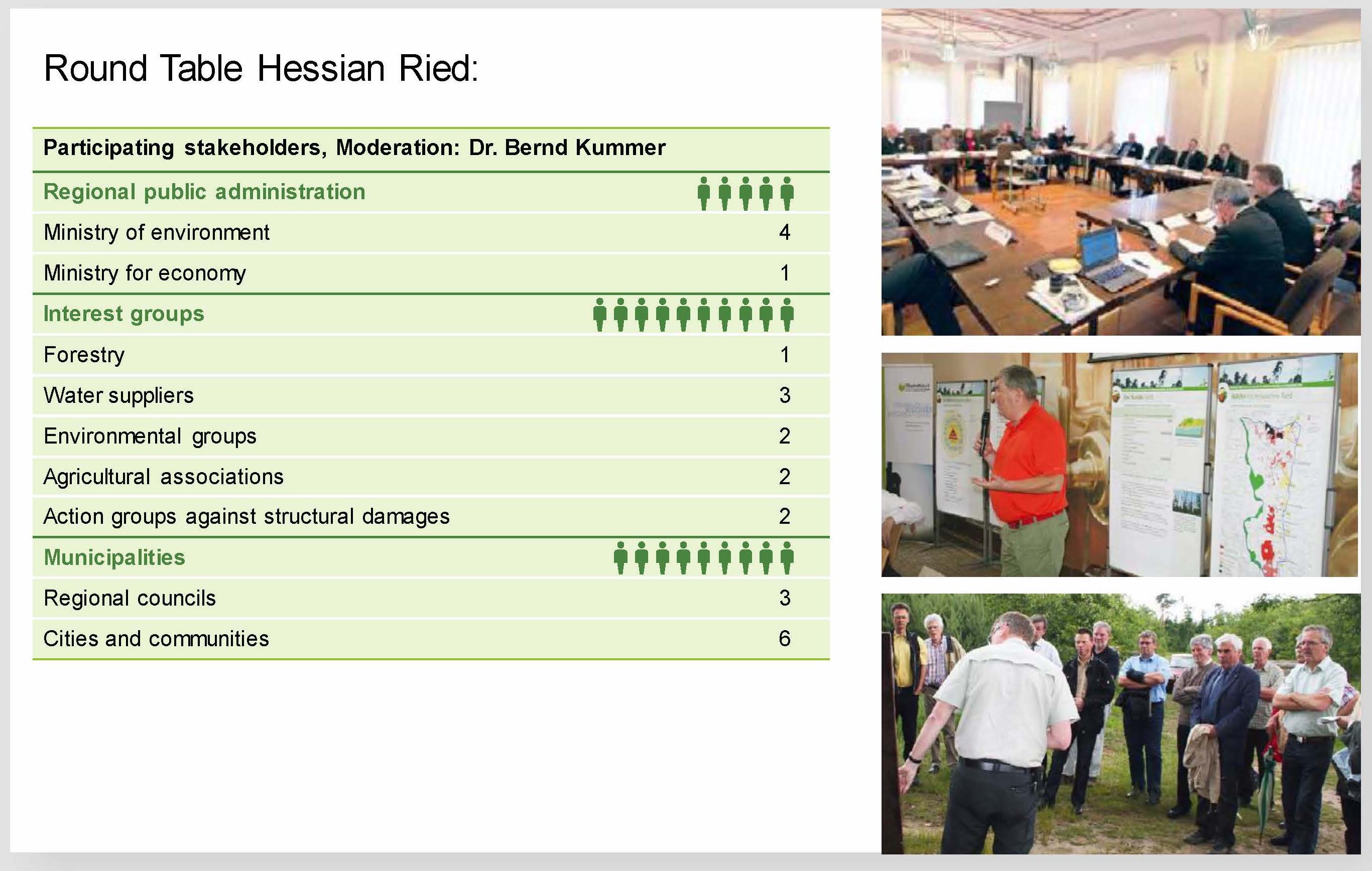 Kummer, 2015
Kummer, 2015
The round table brought together all relevant stakeholders including:
- Regional government authorities
- Representatives of different interests (forestry, water suppliers, environmental associations, nature conservation associations, farmer associations, action groups against waterlogging in houses)
- Districts, cities and municipalities.
Participation in the Round Table: Why do stakeholders want to cooperate?
We asked the moderators of the round table discussions for factors which motivated all the groups to participate. They explained that:
- the natural conditions in the region are extremely complex and actions in one sector directly impact the other. That means, if you don’t participate, you lose. AND
- some solutions are only possible through dialogue and cooperation. Strong interconnections between agriculture, forestry, groundwater and human settlements. Any decision in one sector directly affects the others. Based on previous experience, the actors know that they have to cooperate, otherwise decisions and changes can create negative impacts on their sector. = If you do not participate, you lose
Round Table Challenges*
The round table discussions took three years. The final report was published 2015. We asked the moderators which were the challenges related to the round table discussions. They highlighted :
- Costly process in terms of time and money
- The cross-sectoral complexity of the subject required a lot of expertise
- And last but not least the lack of political will to implement the recommendations elaborated by the round table.
However, it is an instrument with huge potential to solve environmental conflicts.
*Interview with Christoph Ewen responsable for the communication process in the round table conducted on 28.11.2017
Solutions: Cooperation in water supply and agriculture
In Germany, the best practices of agricultural fertilisation are thoroughly regulated in the Fertiliser Ordinance. In water protection areas, the Water Law enables the possibility to make additional rulings that go beyond the existing regulations. However, in numerous instances the protected area regulations were outdated or lacking in specificity, hence the need for voluntary cooperation.
One of the examples of voluntary cooperation is the strong cooperation between water suppliers and the agricultural sector (agricultural cooperation) that aims at reducing nutrient pollution.
Motivation factors for the cooperation:
Generally, the various actors are willing to cooperate if they see a usefulness in working together. In the case study of Hessian Ried, the following motivation factors could be identified:
Water sector: Water supply actors have a deep interest in a safe groundwater supply and see common interests in cooperation with the agricultural sector in water protection areas.
Agricultural sector: The State of Hesse and water authorities provided financial support to offer consultation services for the farmers. Technical experts help the farmers to develop a targeted, nutritional fertiliser plan that is based on information gathered from their fields and considering the nutritional needs of the cultivated crops and the specific soil conditions of each cultivation area. This should optimise the use of fertilisers and thus reduce the risk of nitrogen leaching.
Benefit for the farmers: Through the recommendations of the technical experts, the farmers can implement new farming technology, reduce the use of chemical fertiliser and improve the quality of the crops offering ecological products.
Positive results coming from this cooperation: Success of the agricultural cooperation was seen in the form of a declining nitrate concentration in the water. This became apparent after several years due to long residence times of the nitrogen in the soil.
<hr/>
Summary: Nexus relevant instruments in the Hessien Ried
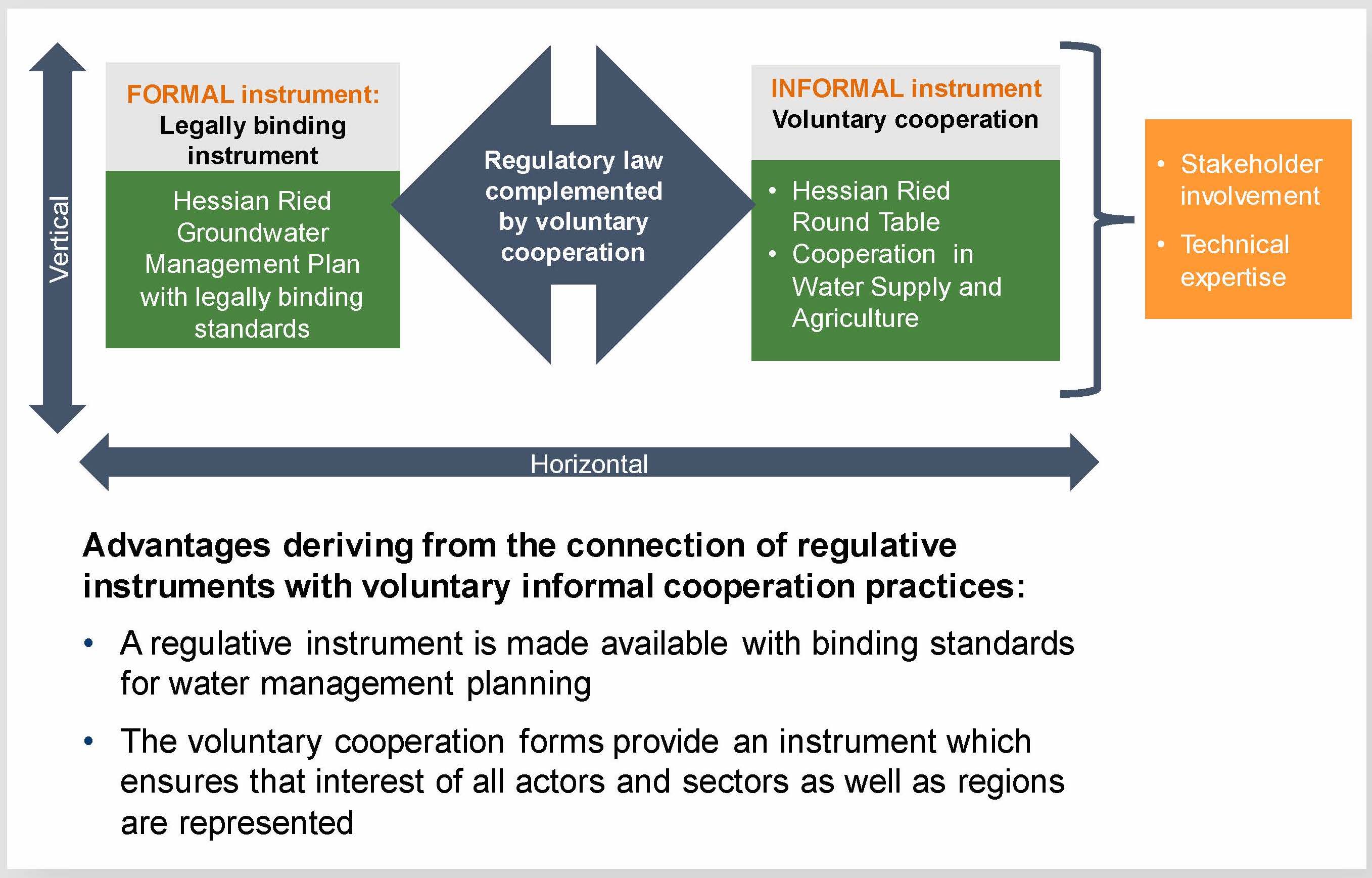
The Hessian Ried Groundwater Management Plan as legally binding regulatory instrument The Hessian Ried Groundwater Management Plan was adopted for the first time 1999 by the Hessian Government with the aim to avoid damages caused by low groundwater levels. The Management plan has been regularly updated (last update 2020).
Voluntary cooperation forms: Through the Groundwater Management Plan, the Hessian Government has provided a legal regulative instrument with binding standards. As a regulatory law instrument, the Groundwater Management Plan is complemented by voluntary regional cooperation forms:
Hessian Ried Round Table Cooperation between water supply and agriculture in the protection of groundwater quality.
Voluntary and informal cooperation cannot replace regulatory law (water protection area regulations, water rights), but it can complement it.
These voluntary informal cooperation practices establish transparency through comprehensive exchange of information, different stakeholders can voice their opinions equally and in detail, and a consensus can be found.
References
Regierungspräsidium Darmstadt. Abteilung Arbeitsschutz und Umwelt Darmstadt. 2020. Grundwasserbewirtschaftungsplan Hessisches Ried. https://rp-darmstadt.hessen.de/sites/rp-darmstadt.hessen.de/files/Grundwasserbewirtschaftungsplan%20Hessisches%20%20Ried%2C%20Stand%202020.pdf
Regierungspräsidium Darmstadt. Umwelt. Hessisches Ried. https://rp-darmstadt.hessen.de/umwelt/gewaesser-und-bodenschutz/grundwasserwasserversorgung/hessisches-ried
Rueppel, U. & Gutzke, T. (2004) ‘Groundwater-Monitoring based on dynamic co-operative eGovernment-Processes’, University of Technology Darmstadt
Wasserverband Hessisches Ried. https://www.whr-infiltration.de/ (Hessian Ried Water Association)